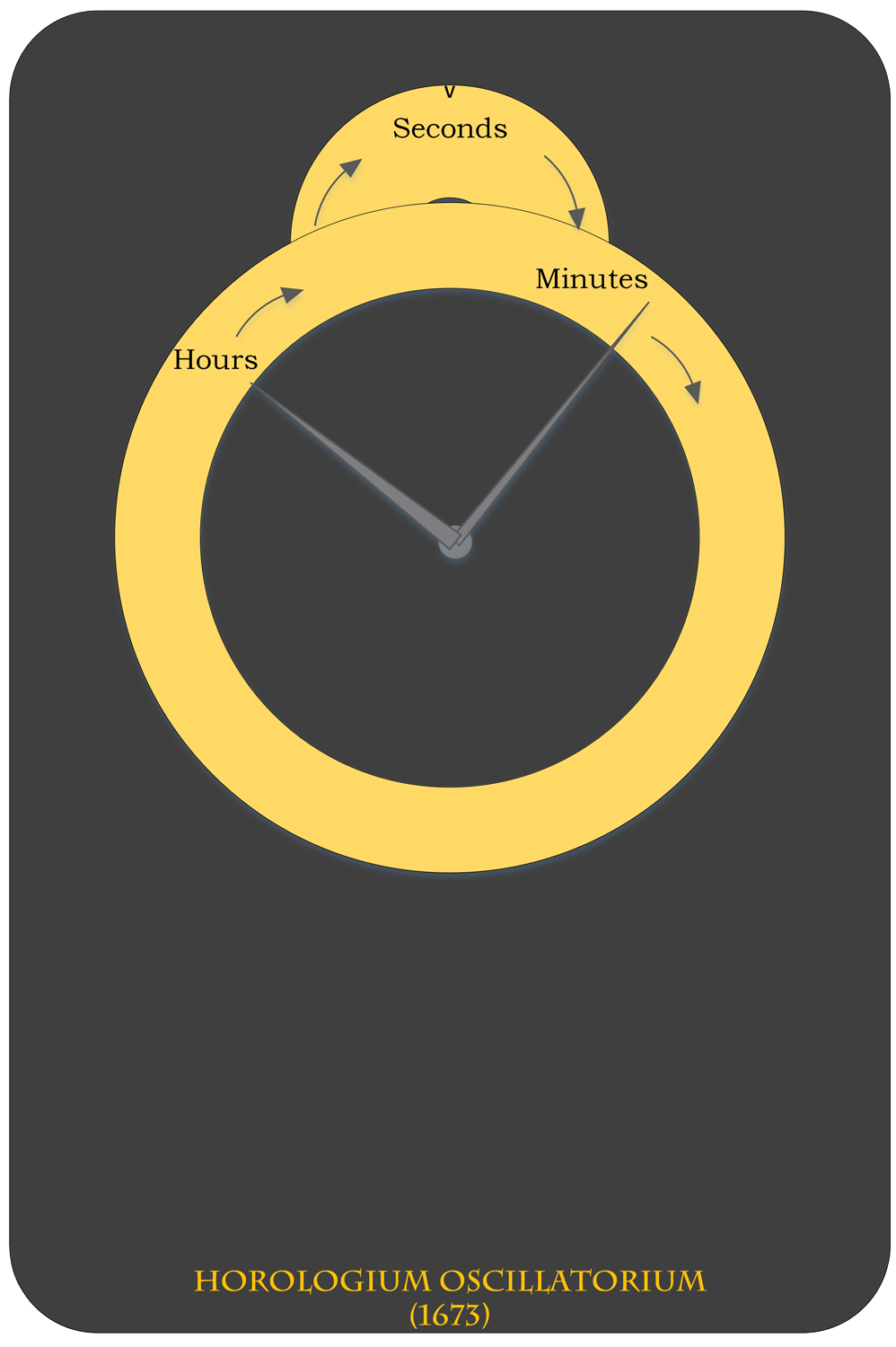|
THE INVENTION OF THE
PENDULUM CLOCK
PART 4/5
The sequel
More inventions

(Type
Ctrl+F
to find any text on this page)
 SETTING
THE SCENE SETTING
THE SCENE
As discussed in part 1 the invention of the pendulum clock is a revolution.
It is the new thing taking Europe by storm. Everyone has to have one! Within a very
short period clocks according to the new application are spread all over
Europe, not only exported from The Hague, but also copied and made locally.
We know that before the end of 1657 a ‘Coster clock’ is in Tuscany. In an
inventory of 1690 a clock signed by Coster is mentioned to have arrived on 25
September 1657, as the first pendulum clock in Italy. Treffler used this clock
as example to make his own. The movement of this latter clock is still existent
today (1.
On 28 October 1658 Fromanteel publishes his famous advertisement in the
Mercurius Politicus about the
availability of a new type of clock(2.
From then on pendulum clocks also take England by storm.
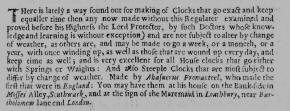
Fromanteel's advertisement October 1658
From Huygens’ correspondence we know a great many pendulum clocks are shipped
from The Hague to Paris, mainly by mediation of Nicolas Hanet(3.
When Huygens is in Paris again in 1660, he mentions in a letter to his brother
Lodewijk in The Hague, there are three or four masters in Paris who make
pendulum clocks and that even some are starting to convert turret clocks(4.
In his diary of that same trip we read he meets up several times with
clockmaker Gilles Martinot(I,
who
resides in Les Galeries du Louvre at
that moment. They already discuss applying a spring to the balance wheel of a
watch and the application of the ‘boxhoorns’(5
(cycloidal cheecks).
Even though we know Visbagh takes over Coster’s shop end of 1660, Huygens, when
in Paris in the spring of 1661 (Saturday 12 March), still talks on behalf of
the widow of Salomon Coster to Petit, bookseller and reseller of pendulum
clocks in Paris. In the further developments, experiments and other inventions
Visbagh does not play a prominent role.
From early 1662 Christiaan and his brother
Lodewijk, who is in Paris at that time, are mediating in the supply of clocks
made in The Hague and sent to Paris. We learn Claude Pascal starts making a
pendulum clock for Mr. Chaise in the third week of January(6. By
the end of February the clock by Pascal is almost ready and previewed by
Huygens(7.
 HUYGENS
AND THURET HUYGENS
AND THURET
Early April 1662 Huygens is very much taken by the comment from his father
that he would readily give ten to twekve Pistoles(II
more for a clock made in Paris by Thuret(III
than he would for his own ‘Dutch’ clock. He would very much like to know what
the French do differently, so it could perhaps also be done like that in The
Hague(8.
About half a year later we learn Thuret is making clocks with a 3 foot
pendulum, indicating seconds. This clock, made for Monsieur Cheureusse(III,
goes very well, just like Petit’s own clock with a 3-foot pendulum (1-second
pendulum). The smaller clocks with a pendulum of 9 or 10 inches (½-second
pendulum) are not as good as the ordinary ones
(9.
On 28 March 1663 Huygens leaves for another journey to Paris and London. He
arrives in Paris 6 April, where he stays until 2 June. He then leaves for
London where he arrives eight days later on 10 June. The first of October he is
back in Paris, where he will stay until June the next year. He returns to The
Hague on 27 June 1664. While in Paris, Christiaan, together with his brother
Lodewijk now in The Hague, continues mediating in ordering pendulum clocks from
Pascal for French clients(10.
Early 1664 he is not too satisfied by the
work of Pascal and as he does not want to lose face himself nor damage the
reputation of Pascal, he gives a ‘rather
long lesson to Sieur Pascal’.
We also learn something about packaging of the clocks, as he urges Lodewijk to
make sure they are packed better and all the pieces well attached, because in
one of these last he had found the ‘countwheel’ disconnected and this had
broken one of the side windows, and some of the pegs rolled through the box(11.
Three months later Huygens is still not satisfied with the work Pascal has
done. He does keep writing with affection towards Pascal. We also see Huygens now
makes use of the services of Thuret to fix the broken clocks(12.
The next day three earlier ordered clocks arrive, but two of the three are in
terrible state: the one with tortoise and the one going for eight days.
‘All kinds
of pieces of the first came loose, and the axes of three or four wheels were
broken. In the end the whole thing was upside down and mixed with the broken
glass powder, that has scratched all the copper in a strange way.
With the one of eight days the bell is in pieces, the tail of the hammer and
some other parts broken, because the movement has detached from the dial plate,
and rolled thus through the case, which is also very damaged at the sides. The third
clock miraculously remained intact, lying between the two others’(13.
Huygens mostly blames customs in Peronne(V,
but partly also Lodewijk and Pascal as they did not provide each clock with its
own box.
Huygens brings the first clock (with tortoise) to Thuret with whom he looks for
all the loose pieces, and leaves it with Thuret to fix. The other of eight days
was ordered for Mr. Merat and Huygens leaves it up to him to decide what to do
with that one.
Huygens is now very fed up with ordering clocks from The Hague and promises
never to order any clock again from Holland(14.
Some two weeks later things are not as bad as they first seemed and Huygens has
calmed down a bit. At least he does not want Pascal to suffer any loss by what
has happened to both damaged clocks. This risk should be entirely for those who
have ordered them.
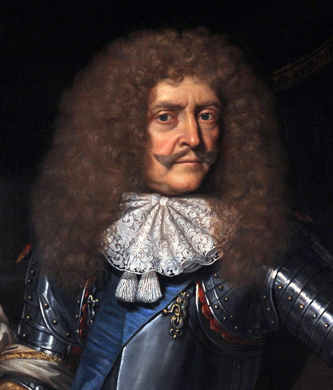
Mareschal de Grammont
Two of the clocks, the one that was not damaged and the one going for eight
days were ordered by ‘Mareschal de Grammont’(VI.
Where the first one has already been delivered and paid for, the other one is
still with Thuret to be repaired, but ‘should
be ready any day now’. The Mareschal is very happy to pay the additional
repair costs as the clock is more beautiful than the one he already has.
Huygens did not hear anything yet from Mr. Merat, who ordered the eight-day
clock.
In the end, after some financial indications, Huygens asks Lodewijk to let
Pascal, or rather the ‘Genevois’(VII
know all this.
 SEA
CLOCKS SEA
CLOCKS
Mid-March 1665 Chapelain writes to Huygens that Thuret came to see him to
offer Huygens his services for the construction, sale and distribution of
pendulum sea clocks. Thuret proposes to pay Huygens for each clock he builds in
his workshop and for a term that he thinks appropriate to exercising his privilege.
‘He (Thuret) hopes for your kindness that you will give him the preference, decided
on his part to give you all the satisfaction that you want to keep up the
reputation of the pendulum clocks as they deserve and for the price that will be agreed
between you and signed before a notary. I believe you know his reputation and
his work so well I
(Chapelain) will not waste time in making sure of it or
recommending it to you’
(15.
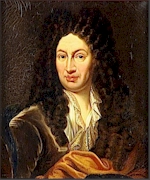
Jean Chapelain
Jean Chapelain is mediating on behalf of Huygens for his privilege for sea
clocks in France. We have just seen that Chapelain also recommends Thuret to be
the ‘preferred one’ as clockmaker to execute this and make the new type of
pendulum clocks. They are thinking of a ‘transport of privilege’ to Thuret for
a period of five or six years. The first step to apply for the privilege is to
publish in the Journal des sçavans of
which Chapelain takes care by the end of March.
Huygens in turn verifies the invention in Amsterdam with some of the
‘seafarers’, but also with cartographers like Blaeu(VIII,
and several navigators, who all confirm the usefulness of the new type of clock(16.
Two types of new ‘privileged’ clocks are being made, one to be used ‘in a room’
and one ‘in a box’ to be used suspended in ships.
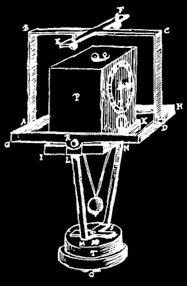
Type 1 sea clock (1665)
The first type we now know already for some years from letters, with a 3-foot
(1 meter) pendulum with horizontal verge escapement and with ‘boxhoorns’ (the
‘cycloidal cheeks’; and subsequently without the O-P construction). The large
dial with two hands coming from the center point, the smallest one indicating
the hours, the largest one the seconds and a smaller dial under the large dial,
indicating the minutes.
The sea clocks have the same dial layout,
but they are placed in a gimballed and suspended box and fitted with a triangle
pendulum, all to deal with the rocking of a ship. We do not know any surviving
sea clocks.

Part of the invention is a remontoir Huygens is using to get the clocks keeping
time more exactly. A remontoir is not something new, but was already known in
all kinds, shapes and forms.
Indeed, in the text of the patent granted by
the States-General, we find the words: 'In
welcke een cleyn gewicht binnen het werck is, alleen het schakelradt
omdrijvende,' t welck t'elckens door het groote gewicht wert opgewonden'(IX.
The Dutch privilege only incorporated the
weight driven remontoir(17.
In the same year in France King Louis XIV granted Huygens the privilege 'for the use of pendulum clocks at sea'(18.
Although other clockmakers also ask Huygens for the privilege to make and sell
sea clocks, he remains loyal to Thuret(19.
Huygens also mentions something about the pocket watches regarding the new
edition to the invention (the remontoir) and that it is not new at all here, as
already watches exist that rewind every hour. He will not apply for a privilege
on this, because if it would be successful it would ruin the clockmakers and he
would not be able to embrace so many new things(20.
With a Power of Attorney from Huygens, Chapelain negotiates the conditions of
the manufacture and distribution of the sea clocks. As said before this is
considered for five or six years. Huygens prefers a fee per sold clock, instead
of a yearly one or one big sum at once. They also create a ‘stamp’ or punch
mark to separate the privileged clocks from possible fakes(21.
The suggested retail price for the sea clocks is 300 Livres and Huygens will
take a third or 3 Louis d’Or as fee (± 100 livres)(X.
We do not know the retail price for the land clocks, but the fee here is only two
Louis d’Or(22.
Thuret at this time is also experimenting to compensate the inaccuracy at the
beginning and the end of the springs which drive the clock. He uses two barrels
of which one each hour rewinds the other, so the primary driving spring winds
down only one hour, which greatly reduces the inaccuracy of the springs worn
down from beginning to end greatly(23.
There is still quite a good deal of trust between Thuret and Huygens as they do
discuss swindling by selling clocks without the privilege punch by Thuret and
by others(24.
The manual of how to use the sea clocks in operation(XI
is now also being translated into French(25.
In August 1665 Huygens sends two new sea clocks to Paris, one for P. de Carcavi
and one for H.L.H de Montmor. Some improvements have been made in the
suspension to cover for the movement of a ship, but the main change is the
addition of the remontoir(26.
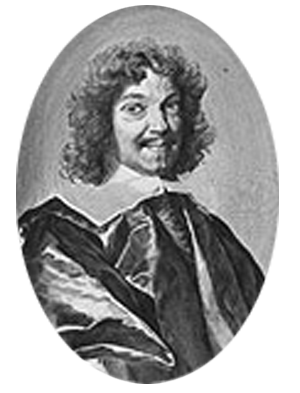 |
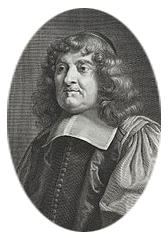 |
|
H.L.H. de Montmor |
P. de Carcavi
|
Early September De Montmor lets Christiaan know the clocks have arrived and are
installed by Thuret to show to a large group of interested people(27.
We also see some try-outs of what later becomes the spiral balance spring in
watches, but for now is applied to the escape wheel of a long pendulum clock: ‘I saw therefore in his machine that he had
engaged in the inner turn of the wheel which moves the one of encounter a small
very narrow spring, which at each turn of the wheel went up and returned to the
same point by the force of the great spring of matter that the little one only
spreading itself with a very small median, it could not fail to maintain such a
vigor, whence the parity of the movement of the pendulum was necessarily
necessary, and thus the equality of the hours by the parity of the moments’
(28.
This is acknowledged by Huygens in his reply:
‘That the invention of Thuret perfectly matches the one
that by my opinion has been made here to regulate a pocket watch, where I had
tried to attach the small spring on the axis of the escape wheel, but that it
would require too much delicacy in the spring and in the movement. So I advised
that it is attached to the axis of the next wheel, and that this is fine.
The clockmaker is after the ability to advance or delay the movement. This
invention is only a subsidiary to mine, using springs where I have used
weights, but that if we wanted it to be used for the big sea clocks. I would be
very wrong if we find the same correctness as with the counterweights to
satisfy the fact of the Longitudes, as the springs must operate all days with
the same force as the weights. Mr. Thuret will be able to see by experience
that this is the case if he wants to make such horologies that show the seconds’(29.
Unfortunately we do not know of the existence of any of these clocks, nor do we
get any more information on the continuation of the sea clocks until several
years later.
Thuret’s name is mentioned in account books from 1669 onwards for works made
for the Académie Royale des Sciences
and, three years later, also for the maintenance of all pendulum clocks of the
observatory and the academy(30.
Christiaan leaves for Paris 21 April 1666 where he stays for ten years(XII, except
for a return to The Hague for nine months between 9 September 1670 and 12 June
1671. In 1673, still in Paris, Huygens publishes Horologium Oscillatorium and dedicates this to Louis XIV.
Next to the very challenging task of keeping a pendulum clock going at sea with
the required accuracy, the trials at sea bring up another, quite unexpected
drawback of using a pendulum. The trip to the America’s of 1672-3 revealed that
the length of a one-second pendulum is not a universal measure but depends on
latitude, mainly caused by differences in gravity in different places on the
earth(31.
Huygens had to face the fact that the pendulum as a timekeeper at sea had not
only practical but also more fundamental disadvantages.
endsection
%20kopie.gif)
Type 2 sea clock (1672)
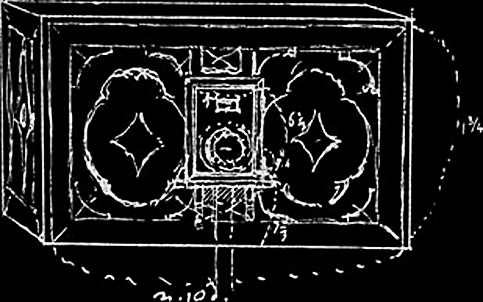
Type 3 sea clock (1694)
From 1675 Huygens shifts his attention to the spiral balance spring in watches.
Another invention with quite some controversy, contending rivals and turmoil.
In England Hooke made claims and in France we see Thuret claiming the
invention.
End
of this section, click
here to continue.

 NOTES
NOTES
|
I |
Giles Martinot (I), Aux Galeries du Louvre; °1622 - †1669; From
1658 he works togethe<>r with his son Henri Martinot (°1646 - †1725), who takes
over after his father’s death. |
|
II |
One pistole was worth approximately ten
livres or three écus. One pistole was worth
approximately ten livres or three écus |
|
III |
This is the first time Huygens mentions Thuret by name in his
Oeuvres Complètes |
|
IV |
Claude de Lorraine, Duke of
Chevreuse, husband of Marie de Rohan, Duchess of Chevreuse (1600 – 1679).
Claude de Lorraine, Duke of
Chevreuse, husband of Marie de Rohan, Duchess of Chevreuse (1600 – 1679). In
1659 (16 January) DuGast orders a clock for Marie with Huygens and Coster
(OC,
No 567) |
|
V |
Péronne, on the banks of the river Somme. In 1664 it was near the
French – Netherlands border. |
|
VI |
Antoine III Agénor de Gramont, Duke of Gramont, etc. (1604 – 1678)
was a French military man and diplomat, and from 1641 Marshal of France. |
|
VII |
The Genevois is a former province of the Duchy of Savoy. Its
capital is Annecy. Although the province took its name from the city of Geneva,
the city itself is not part of it. |
|
VIII |
Dr. Joan Willemsz. Blaeu (Amsterdam, 1596 -
Amsterdam, 1673).
In
1620 he became a doctor of law but he joined the work of his father, a
cartographer. In 1635 they published the Atlas Novus. Joan became the official
cartographe<>r of the Dutch East India Company. |
|
IX |
'In which is a small weight within
the movement, only entwining the escapewheel, which is always wound by the big
weight' |
|
X |
The actual value of the coins
fluctuated according to monetary and fiscal policy, but in 1726 the value was
stabilised and set to 20 livres. In 1740 it was revalued to 24 livres, thereby
effecting a 20% devaluation of the livre. |
|
XI |
KORT ONDERWYS Aengaende het gebruyck Der HOROLOGIEN Tot het vinden der Lenghten
van Oost en West, Christiaan Huygens, 1665 |
|
XII |
Christiaan
leaves Paris with Philips Doublet, his brother in law, on 1 July 1676 to arrive
back in The Hague on 14 July 1676 |
|
XIII |
François d'Aubusson de La Feuillade, known as 6th duc de
Roannais (1631 – 1691) was a French military officer and noble who served in
the wars of Louis XIV and became a Mar<>shal of France. |
|
XIV |
Blaise Pascal (1623 – 1662) was a French mathematician, physicist,
inventor, writer and Catholic theologian. |
|
XV |
Giles Martinot (I), Aux Galeries du Louvre; °1622 - †1669; from
1658 he works together with his son Henri Martinot (°1646 - †1725), who takes
over after his father’s death. |
|
XVI |
Jean de Hautefeuille, son of a
baker, was born on March 20, 1647 in Orléans, where he died October 18, 1724.
He was abbot and entered, in 1686, in the service of the Duke and Duchess of
Bouillon. |
|
XVII |
Charles Honoré d'Albert de Luynes
(7 October 1646 – 5 November 1712) was a French nobleman and Duke of Luynes. He
is best known as the Duke of Chevreuse till his father's death in 1690. He was
a high-ranking French official under King Louis XIV.
He also was the son-in-law of
Colbert. |
|
XVIII |
The title,
Marchand Horloger Privilégié du Roi, indicates that the bearer
belonged to an original institution of the French monarchy which assembled
various professions into a single body governed by the legal structure,
Les Marchands Privilégiés Suivant La Cour.
It was founded in 1485 during the reign of Charles VIII by the regent, Anne de
Beaujeu. Its original purpose was to
supply the King’s court with food and provisions during its constant moves
across the country. The marchands
were required to set up shop wherever the ruler was, and close down within
three days of his departure. Later on, Henri III added two clockmakers to the
marchands, and in 1672, four was the set
limit.
|
|
XIX |
20 Sol = 1 Livre; 24 Livres = 1
Louis d’Or |
|
XX |
There is
one other clock, not signed, but owned by the Danish astronomer Ole Rømer, made after an example made by
Thuret; Antiquarian Horology 30/5 (March 2008), pp. 624-628.
Recently
another ‘regulator’ was discovered, signed Langlois
Paris, Antiquarian Horology 38/3 (September 2017), pp. 365-384. |
|
1 |
R. Plomp, "Spring-driven Dutch
pendulum clocks 1657-1710", Interbook (Schiedam), 1979, pp. 15 |
|
2 |
Mercurius Politicus, issue number
439, October 21-28, 1658; as reproduced in Penney, op.cit., 619-620. In this
article I made use of the work and the article of David
Penney, "The Earliest Pendulum Clocks: A Re-Evaluation", Antiquarian
Horology, Volume 31 No 5, (September 2009), pp. 614-620. |
|
3 |
Oeuvres Complètes de Christiaan Huygens, Tome Deuxième,
correspondance 1657-1659, Martinus Nijhoff, 1889, No. 605, pp. 382; No. 670,
pp. 486 |
|
4 |
Oeuvres Complètes de Christiaan Huygens, Tome Troisième, correspondance
1660-1661, Martinus Nijhoff, 1889, No. 815, pp. 192 |
|
5 |
Oeuvres Complètes de Christiaan Huygens, Tome Dix-Septième, L'horloge à
pendule 1656-1666, Martinus Nijhoff, 1932, Horloges marines (et sympathie des
horloges) IV, pp. 171-179 |
|
6 |
Oeuvres Complètes de Christiaan Huygens, Tome Quatrième,
correspondance 1662-1663, Martinus Nijhoff, 1891, No 955, pp. 11 |
|
7 |
Oeuvres Complètes de Christiaan Huygens, Tome Quatrième,
correspondance 1662-1663, Martinus Nijhoff, 1891, No 983, pp. 63-65 |
|
8 |
Oeuvres Complètes de Christiaan Huygens, Tome Quatrième,
correspondance 1662-1663, Martinus Nijhoff, 1891, No 1004, pp. 110 |
|
9 |
Oeuvres Complètes de Christiaan Huygens, Tome Quatrième,
correspondance 1662-1663, Martinus Nijhoff, 1891, No 1078, pp. 270 |
|
10 |
Oeuvres Complètes de Christiaan Huygens, Tome Quatrième,
correspondance 1662-1663, Martinus Nijhoff, 1891, No 1189, pp. 477 |
|
11 |
Oeuvres Complètes de Christiaan Huygens, Tome Cinquième,
correspondance 1664-1665, Martinus Nijhoff, 1893, No 1207, pp. 18-19 |
|
12 |
Oeuvres Complètes de Christiaan Huygens, Tome Cinquième,
correspondance 1664-1665, Martinus Nijhoff, 1893, No 1227, pp. 58 |
|
13 |
Oeuvres Complètes de Christiaan Huygens, Tome Cinquième,
correspondance 1664-1665, Martinus Nijhoff, 1893, No 1228, pp. 59 |
|
14 |
Oeuvres Complètes de Christiaan Huygens, Tome Cinquième,
correspondance 1664-1665, Martinus Nijhoff, 1893, No 1228, pp. 60 |
|
15 |
Oeuvres Complètes de Christiaan Huygens, Tome Cinquième,
correspondance 1664-1665, Martinus Nijhoff, 1893, No 1352, pp. 268 |
|
16 |
Oeuvres Complètes de Christiaan Huygens, Tome Cinquième,
correspondance 1664-1665, Martinus Nijhoff, 1893, No 1356, pp. 277 |
|
17 |
Oeuvres Complètes de Christiaan Huygens, Tome Dix-Septième, L'horloge à
pendule 1656-1666, Martinus Nijhoff, 1932, Horloges marines (et sympathie des
horloges) IV, pp. 173 |
|
18 |
Oeuvres Complètes de Christiaan Huygens, Tome Cinquième,
correspondance 1664-1665, Martinus Nijhoff, 1893, No 1358, pp. 278 |
|
19 |
Oeuvres Complètes de Christiaan Huygens, Tome Cinquième,
correspondance 1664-1665, Martinus Nijhoff, 1893, No 1361, pp. 281 |
|
20 |
Oeuvres Complètes de Christiaan Huygens, Tome Cinquième,
correspondance 1664-1665, Martinus Nijhoff, 1893, No 1370, pp. 301 |
|
21 |
Oeuvres Complètes de Christiaan Huygens, Tome Cinquième,
correspondance 1664-1665, Martinus Nijhoff, 1893, No 1408, pp. 358 |
|
22 |
Oeuvres Complètes de Christiaan Huygens, Tome Cinquième,
correspondance 1664-1665, Martinus Nijhoff, 1893, No 1409, pp. 358-359 |
|
23 |
Oeuvres Complètes de Christiaan Huygens, Tome Cinquième,
correspondance 1664-1665, Martinus Nijhoff, 1893, No 1417, pp. 371 |
|
24 |
Oeuvres Complètes de Christiaan Huygens, Tome Cinquième,
correspondance 1664-1665, Martinus Nijhoff, 1893, No 1430, pp. 398 |
|
25 |
(
Oeuvres Complètes de Christiaan Huygens, Tome Cinquième,
correspondance 1664-1665, Martinus Nijhoff, 1893, No 1429, pp. 396-397 |
|
26 |
Oeuvres Complètes de Christiaan Huygens, Tome Cinquième,
correspondance 1664-1665, Martinus Nijhoff, 1893, No 1444, pp. 438 |
|
27 |
Oeuvres Complètes de Christiaan Huygens, Tome Cinquième,
correspondance 1664-1665, Martinus Nijhoff, 1893, No 1454, pp. 476-477 |
|
28 |
Oeuvres Complètes de Christiaan Huygens, Tome Cinquième,
correspondance 1664-1665, Martinus Nijhoff, 1893, No 1485, pp. 511 |
|
29 |
Oeuvres Complètes de Christiaan Huygens, Tome Cinquième,
correspondance 1664-1665, Martinus Nijhoff, 1893, No 1491, pp. 525 |
|
30 |
Oeuvres Complètes de Christiaan Huygens, Tome Dix-Huitième, Avertissement,
Martinus Nijhoff, 1934, pp. 505, note 9, ‘les Comptes des Bâtiments du Roi’,
sous le règne de Louis XIV (1664-1687), published by J. Guiffrey (Paris, 1881).
Here is also mentioned a planetarium in 1680, a 'machine for measuring the
eclipses' in 1682 and a 'parallax machine for observations' in 1687, all made
by Thuret. |
|
31 |
Oeuvres Complètes de Christiaan Huygens, Tome Septième,
correspondance 1670-1675, Martinus Nijhoff, 1897, No 1853, pp. 117, note 12.
The source is 'Observations astronomique et physique faites en l'isle de
Caïenne' published in the Mémoires de l'Académie Royale des Sciences depuis
1666 jusqu'à 1699, II, part 1 (Paris, 1729). |
|
32 |
William Derham, The Artificial Clockmaker, London, 1696, pp. 99 |
|
33 |
Oeuvres Complètes de Christiaan Huygens, Tome Cinquième,
correspondance 1664-1665, Martinus Nijhoff, 1893, No 1435, pp. 427 |
| |
|

|
 THE
SPIRAL BALANCE SPRING IN WATCHES
THE
SPIRAL BALANCE SPRING IN WATCHES
The pocket watches of this type were at the time called: ‘pendulum
watches’. This stems from the regularity of their strokes and motion, which
were supposed not to be inferior to those of a real pendulum. This exactness is
effected by the government of a small spiral spring running around the upper
part of the verge of the balance
(32.


The idea of applying a spring to regulate
a clock was not new in 1675. We have to step back in time to the first
indications in records on a spring-equipped balance wheel.
First we hop to 1665 when Moray reports on one of Hooke’s lectures on Mechanics
for the Royal Society where he shows “an
entirely new invention, or rather about twenty, to measure time just as
accurately as your pendulum movements do, both at sea and at land, which cannot
be hindered at all by its changes of state or even of the air. In short, it is
by attaching to the balance, instead of a pendulum, a spring, which can be done
in a hundred different ways, and even he has sustained us with an argument in
which he has undertaken to prove that it is possible to adjust the deviations
so that, either small or large, they will be Isochronous”(33.
In his answer Huygens takes us even further back to 1660 when he was in Paris
when the Duke of Roannais(XIII
spoke of the same and even took him to the clockmaker to whom he and Mr. Pascal
(XIV
had communicated this invention, but under oath and promise for the Notary not
to reveal it or to appropriate it.
Huygens however did not really like their way of application, and learned much
better since then, but besides that its practice is not as simple as that of
pendulum movements, one cannot expect as much accuracy as can be found in the
latter, since the movements of the ship must cause minor irregularities in the
movement of the spring, which would be difficult to correct. And it is not yet
known whether a change of temperature would influence the vibrations(34.
Having stepped back to 1660, let’s stay there for a moment.
At the end of 1660 Huygens is in Paris and on 4 November he
mentions in his diary(35
for the first time a visit to Martinot, l’horloger(XV.
We can read in the same diary he meets up several times with Gilles Martinot,
who resides in Les Galeries du Louvre
at that moment. Already they discuss the application of a spring to the balance
wheel of a watch.
Huygens later does call him ‘one of the
biggest braggarts in the world, otherwise quite competent in his field’(36
So, it is very likely that even before 1673 Huygens had thought of dealing
himself with the question of the regulating spring, since he said in September
1675 (T. V, 486) that as early as 1660 he
did not find the way to apply the spring he had seen in France and that he
already knew at that time 'much better'.
We unfortunately do not know exactly on what Martinot, inspired by the Duke of
Roanais and Bl. Pascal, was working on in 1660, or what other French
watchmakers, or R. Hooke, had been able to conceive. We do kow that until then
the application of a spiral spring in the regulation of watches had hardly been
considered, and we do not know of any practical use of a balance spring prior
to 1675.
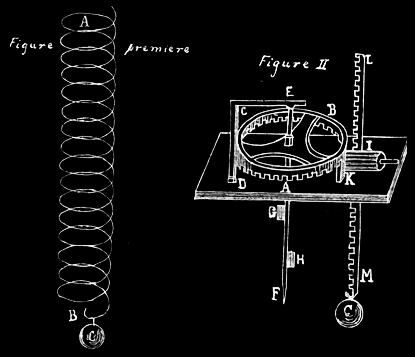
Hautfeuille's claim
Jean de Hautefeuille(XVI
makes a claim on the balance spring regulation of watches. His principle of using
helical springs is however completely different from the radial spring. Even
more, if De Hautefeuille had knowledge of the application of a spiral spring to
the balance before 1675, he would surely have mentioned this in the
Factum touchant les Pendules de poche. The
charges made by De Hautefeuille were not further prosecuted(37.
Huygens obtained the privilege for ‘portable clocks both on land and at sea’ for France on 15 February 1675
(38.
The States of Holland and West-Friesland granted him this on 4 October 1675 for
15 years, ‘for newly invented marine clocks, but not yet built’(39.
The privilege Huygens had obtained remained however useless. All the watchmakers
of Paris made spiral spring regulated watches, without paying the fee of a ‘Louis
d’Or’ - which some had already paid(40.
Huygens invents the spiral spring-regulated pendulum on 20 January 1675. He
works together with Thuret to make a model two days later, later also shown to Colbert
himself. Huygens denies Thuret a share in the benefits of the invention. On the
first of February Thuret shows the new invention and makes it look like he did have
a very large share in it(41.
The secret of Huygens’ invention consists
of a spring turned in a spiral, attached at its inner end to the shaft of a
balance beam, but larger and heavier than usual, which turns on its pivots; and
by its other end to a piece attached to the (back)plate of the clock. This
spring, when one sets the pendulum in motion, alternately squeezes and loosens
its turns, and keeps, with the little help coming from the wheels of the clock,
the pendulum moving, so despite irregular turns of the balance, the pendulum
oscillations are equal.

Huygens' Spiral balance spring 1675
In the figure the top plate of the clock is AB; The circular pendulum (balance
wheel) CD; whose axis is EF. The spiral spring GHM, attached to the balance axis
in M, and to the piece that holds the plate of the clock, in G; all the turns
of the spring are up in the air without touching anything. NOPQ is the cock in
which turns one of the pivots of the pendulum (balance). RS is one of the
cogwheels of the clock, having a rocking motion that passes it on to the escape
wheel. And this RS wheel intervenes in pinion T, which is attached to the
balance axis, which by this means the movement is kept going as much as
necessary(42.
By the end of February Thuret already several times had made his excuses to
have claimed more honour than was his. In April, as a final propitiation, he proposes
to write a formal letter of excuse to the Duke de Chevreuse (Charles Honoré
d'Albert, duc de Luynes(XVII
(43.
Only several months later, this letter, dated 10 September 1675, finds its way
to Huygens. In this letter Thuret explicitly admits to consider the spiral
spring as the exclusive invention by Huygens, although he still does suggest
that the displeasure of Huygens somehow may have had its origin in the fact
that Thuret recently made some clocks with a pendulum attached to a straight suspension
spring instead of a thread(44.
Huygens seems to accept the excuse and grants Thuret the privilege to make
clocks using the newly invented spiral spring(45.
Also in November, he even sends Oldenburg a watch made by Thuret with the new
invention and writes in the accompanying letter: ‘It is from Thuret, who until then has made the best and at a good pace.
He is the one who did me so wrong, when I thought of it as an invention, but
having finally renounced it and apologized by a letter, he was obliged to write
to me, I do not make it any more difficult to employ him’(46.
After November 1675, Huygens never talks about Thuret again.
 THE
LIFE OF THURET THE
LIFE OF THURET
Isaac Thuret (ca 1630-1706) and his son Jacques Thuret (1669-1738), both became
Horlogers du Roi. They both signed
‘Thuret’ or ‘I. Thuret’ (There is no difference in the ‘I’ or ‘J’).
Isaac Thuret was born in Senlis around 1630 as the son of a merchant and
shopkeeper in parchment and leather. He was member of the protestant church of Senlis .
Suzanne Thuret (ca 1626 - ?), sister of Isaac married in December 1646 Charles
Sarrabat, Maître Horloger (ca. 1615- <1686) and Marchand-Horloger Privilégié du Roi suivant la Cour Sarrabat retired
in 1678 in favour of Charles Hélot. Isaac may have been apprenticed to Charles
Sarrabat.
Isaac Thuret married in April 1663 Madeleine Hélot and lived in a house in the
Rue Neuve Saint-Louis (Saint Bartholomew Parish) in Paris. He later moved to
the city, La Cité, and from 1686 took
up lodging at the Galeries du Louvre.
Isaac and Madeleine have two children, Jacques III Augustin Thuret, and Suzanne
Thuret (1676-1711), wife of Charles-François Silvestre (1667-1738), designer
and engraver to the king.
Isaac is appointed Marchand-Horloger
Ordinaire du Roi(XVIII before
1663. We do not know when he became master clockmaker, but it has to be before
this date. In exchange for fulfilling their obligations, the privileged
merchants enjoyed legal and fiscal advantages which were subject to the special
jurisdiction of the Conseil d’Etat du Roi.
Only the most skilled of the maîtres horlogers were made Horloger du Roi, and only a few, were given lodgings at the Louvre.
Before 1672 he was also appointed clockmaker of the
Académie Royale des Sciences.
In 1686, he restores the clocks of the Palais
de Fontainebleau. From 1689 until 1694, he also became Horloger de l' Observatoire de Paris to maintain the scientific
instruments in use here.
In 1688, Isaac Thuret was represented by the most famous portraitist of the
reign of Louis XIV, Hyacinthe Rigaud. The painting of which we do not know the whereabouts,
nor even the history, was ordered from the artist for the sum of 67
livres and 10
sols(XIX,
which suggests a representation in bust.

Isaac Thuret (c. 1630-1705)
Jacques III Augustin Thuret (Isaac had a
brother named Jacques (ca. 1625-1680), who had a
son
also named Jacques (1639-?)) was born in 1669. In December 1703, he marries Louise
Bérain, daughter of Jean I Bérain (1637-1711), draughtsman and designer,
painter and engraver, dessinateur de la
Chambre et du cabinet du Roi.
Jacques becomes Horloger du Roi logé aux
Galeries du Louvre in 1694. Probably then he operationaly takes over the
workshop from his father. We do not know when Jacques started working, but most
likely he started as an apprentice in his fathers workshop, and kept working
here. He continued the workshop on his own after his fathers death in 1706.
Jacques Thuret died in 1739.
His portrait was engraved by his niece Suzanne Silvestre after a pastel by
Joseph Vivien.
 THE
WORKS OF THURET THE
WORKS OF THURET
If we take the birth date of Isaac Thuret, mentioned in several sources, as
1630, he marries at a quite advanced age of 33, in 1663. We also know in this
year he is mentioned as Marchand-Horloger
Ordinaire du Roi and Constantijn Huygens Sr. mentions clocks made by Thuret
already in 1662.
.png)
We do not know any still existent ‘prototype’ box clocks made by Thuret. The
first clocks signed Thuret à Paris
are all of the ‘basic type’ religieuse,
with either an ornament or a pediment on top. Of all Pendules Religieuses and baroque clocks, made between 1657 and
1715, still known today, almost
10% is made by the workshop of Thuret. Of these early models, six of the 82
with ornament are made by Thuret and of the 77 with pediment even nine are
signed Thuret à Paris.
.png)
We can follow this ‘productive’ line throughout the era of the reign of Louis
XIV, until 1715, and get an approximate count of 10% of all Paris made religieuses
from this era still in existence today made by the Thuret workshop. One
striking thing is Thuret was not a fan of Boulle work; it is applied to only
very few of his clock cases.
The French did not embrace technical developments, like the anchor escapement,
until far into the 18th century. Maybe caused by the fact longcase
clocks never caught on in France as they did in England and later in Holland.
We currently do not know any longcase with ancre escapement and 1 second
pendulum made by Thuret existing today.
We do still have a few of the scientific
clocks, developed in the late 1660’s/ early 70’s, with a long 3 feet, 2 inches
long pendulum and a verge escapement.
The movements are all perfectly in line with the design presented by Huygens in
Horlogium Oscillatorium (1673).
_full-bw.jpg)
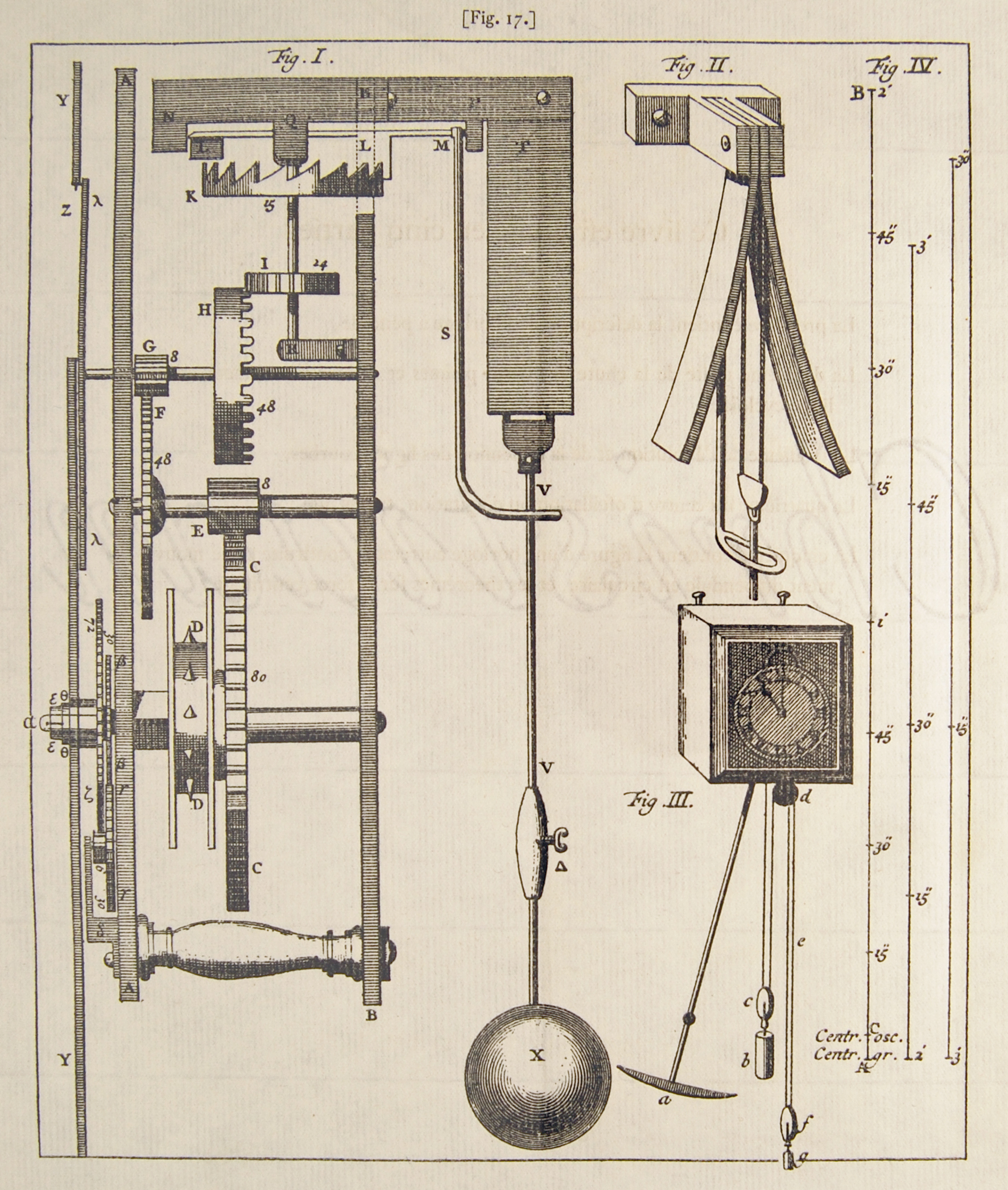
We see however a discrepancy in the dial layout, if we compare the existing
Scientific Clocks with the design presented in Horlogium Oscillatorium. The design presented in
Horologium in 1658 does not fit either.
We need to take a closer look at the evolution in dial layout, both in several
descriptions in Huygens correspondence from his Oeuvres Complètes, and by observing the designs made from the
invention till that finally presented in Horologium
Oscillatorium.
In all clocks mentioned until 1667, from the invention in 1656 and Horologium
in 1658, up till the sea clocks and scientific clocks with long pendulum during
the 1660’s, we see one similar dail plate layout, the one presented in Horologium.
Only towards the publication of Horologium
Oscillatorium (1673) we see a different dial layout. Interestingly the
layout of the dial of the clock presented in Horologium Oscillatorium is different again. Even more interesting
is the fact we do not know any clock still existing with either the dial layout
of Horologium or Horologium Oscillatorium. We do have three examples left of the
scientific type, all made by Thuret(XX.
These are the only ones, currently known and verified, with verge escapement
and 1 second-pendulum.
The evolution of this ‘scientific dial’-layout can be followed by the
development of the sea clocks.
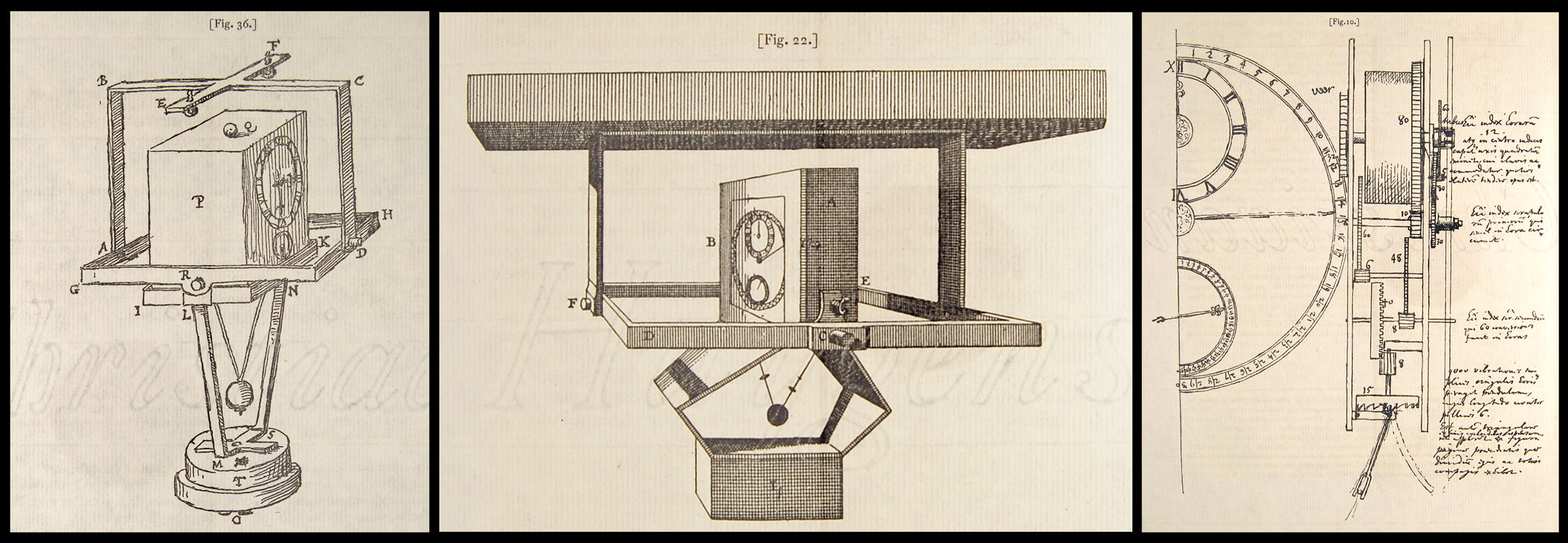
From the correspondence of Christiaan Huygens we know Thuret was involved in
these developments from 1665, and even became the exclusive ‘privileged’
clockmaker of the sea and scientific clocks with long pendulum in France.
Before 1672 Thuret was also appointed as official clockmaker of the Académie Royale des Sciences, the
clockmaker responsible for the maintenance of the machines of the Academy.
The French academy of sciences, l’Académie
Royale des Sciences, met for the first time on 22 December 1666 in the
King's library in the Louvre in Paris. In contrast to its British counterpart,
the Academy was founded as an institution of government.
The British Royal Society was founded, some years earlier, on 28 November 1660.
Christiaan Huygens was a member of both institutions.
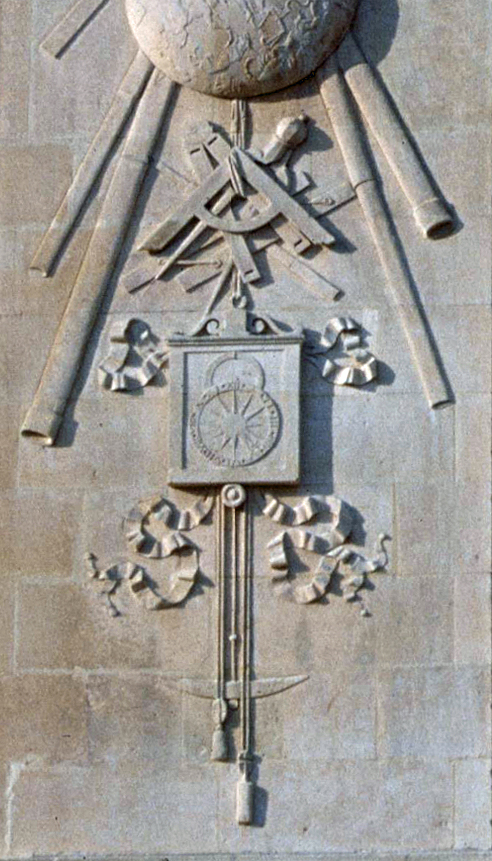
L'Observatoire de Paris
The foundation of the observatory of Paris
originates in the ambitions of Jean-Baptiste Colbert to extend France's
maritime power and international trade in the 17th century. Louis XIV promoted
its construction, which was started in 1667 and completed in 1671. It thus
predates by a few years the Royal Greenwich Observatory, which was founded in
1675. Later on Isaac Thuret also became the official Horloger de l'Observatoire de Paris.
His involvement with the Academy of Sciences and the observatory allowed him to
get in touch with foreign scholars such as Christiaan Huygens and Ole
Christensen Rømer to make and maintain their scientific instruments and clocks.
 TWO
ASTRONOMICAL MACHINES TWO
ASTRONOMICAL MACHINES
During two sessions of the Academy of
Sciences, August 17 and 31, 1680, informed his colleagues of two
projects: the construction of a machine
for planets and a machine for
eclipses which he had invented; one showing the movements of Jupiter and
its satellites, the other, the movements of Saturn and its rings (1678)(47.
At the end of the year 1680, the last demonstrations completed, it was
therefore decided to have the two new machines
built by ‘a clever watchmaker’, in charge of the maintenance of the Academy
clocks, Isaac Thuret. In January 1681, just before his final departure for
Denmark, Rømer showed his machine for the new moons and eclipses to the academicians.
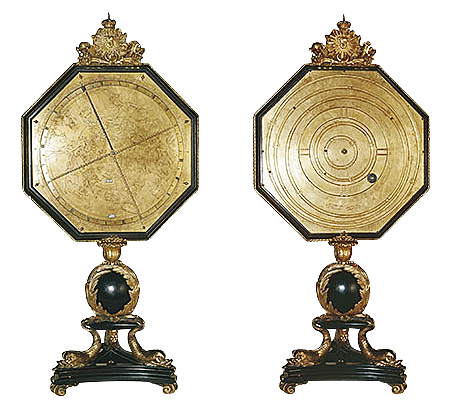
Ole Rømer's
machine
for planets and machine for
eclipses,
made by Thuret.
In spite of
significant progress due to the observation of the rotation of the satellites
of Jupiter, with the more accurate and more frequent results, in 1690 one still
resorted to the observation of the eclipses of moon and sun, when determining
the longitude. This interest of academicians in astronomical observations was
undeniably linked to the desire to produce precise geographical maps, and a
member such as Jean-Dominique Cassini (1625-1712) could only approve Rømer's
guidelines for applied research. The new machines
eclipses were manufactured by Isaac Thuret and allowed to anticipate and
predict the lunar cycle over two centuries, until 1881, with a mistake of one
day. The machine of the planets
presented the movements of the stars of the solar system(48.
 ACKNOWLEDGEMENTS ACKNOWLEDGEMENTS
March
2019, Copyright:
(This article is subject to ongoing
revisions.)
 LINKS
LINKS
Chr.
Huygens' Œuvres Complètes.
(pdf)
The Identification
and Attribution of Christiaan
Huygen's First Pendulum Clock.
Chr.
Huygens Horologium 1658.
(pdf)
|
|
Notes continued |
|
|
|
|
34 |
Oeuvres Complètes de Christiaan Huygens, Tome Cinquième,
correspondance 1664-1665, Martinus Nijhoff, 1893, Appendix to No 1465, pp. 486 |
|
35 |
Oeuvres Complètes de Christiaan Huygens, Tome Cinquième,
correspondance 1664-1665, Martinus Nijhoff, 1893, No 1435, pp. 427 |
|
36 |
Oeuvres Complètes de Christiaan Huygens, Tome Troisième,
correspondance 1660-1661, Martinus Nijhoff, 1889, No. 920, pp. 389 |
|
37 |
Oeuvres Complètes de Christiaan Huygens, Tome Septième,
correspondance 1670-1675, Martinus Nijhoff, 1897, No 2027, pp. 458 |
|
38 |
Oeuvres Complètes de Christiaan Huygens, Tome Septième,
correspondance 1670-1675, Martinus Nijhoff, 1897, No 2011, pp. 419 |
|
39 |
Oeuvres Complètes de Christiaan Huygens, Tome Septième,
correspondance 1670-1675, Martinus Nijhoff, 1897, No 2060, pp. 507-508 |
|
40 |
Oeuvres Complètes de Christiaan Huygens, Tome Septième,
correspondance 1670-1675, Martinus Nijhoff, 1897, No 2023, pp. 453 note 23 |
|
41 |
Oeuvres Complètes de Christiaan Huygens, Tome Septième,
correspondance 1670-1675, Martinus Nijhoff, 1897, No 2008, pp. 408-416 |
|
42 |
Oeuvres Complètes de Christiaan Huygens, Tome Septième,
correspondance 1670-1675, Martinus Nijhoff, 1897, No 2014, pp. 524-425 |
|
43 |
Oeuvres Complètes de Christiaan Huygens, Tome Septième,
correspondance 1670-1675, Martinus Nijhoff, 1897, No 2021, pp. 434 |
|
44 |
Oeuvres Complètes de Christiaan Huygens, Tome Septième,
correspondance 1670-1675, Martinus Nijhoff, 1897, No 2055, pp. 498 |
|
45 |
Oeuvres Complètes de Christiaan Huygens, Tome Huitième,
correspondance 1676-1684, Martinus Nijhoff, 1899, No 2055a, pp. 561 |
|
46 |
Oeuvres Complètes de Christiaan Huygens, Tome Septième,
correspondance 1670-1675, Martinus Nijhoff, 1897, No 2078, pp. 542. |
|
47 |
The Emperor's New Mathematics, Catherine Jami, Oxford University
Press, Oxford, 2012, pp. 105-106 |
|
48 |
History of Astronomy: An Encyclopedia, edited by John Lankford,
Routledge New York/London, 1997, pp. 272-273 |
| |
|

|









%20kopie.gif)






.png)
.png)


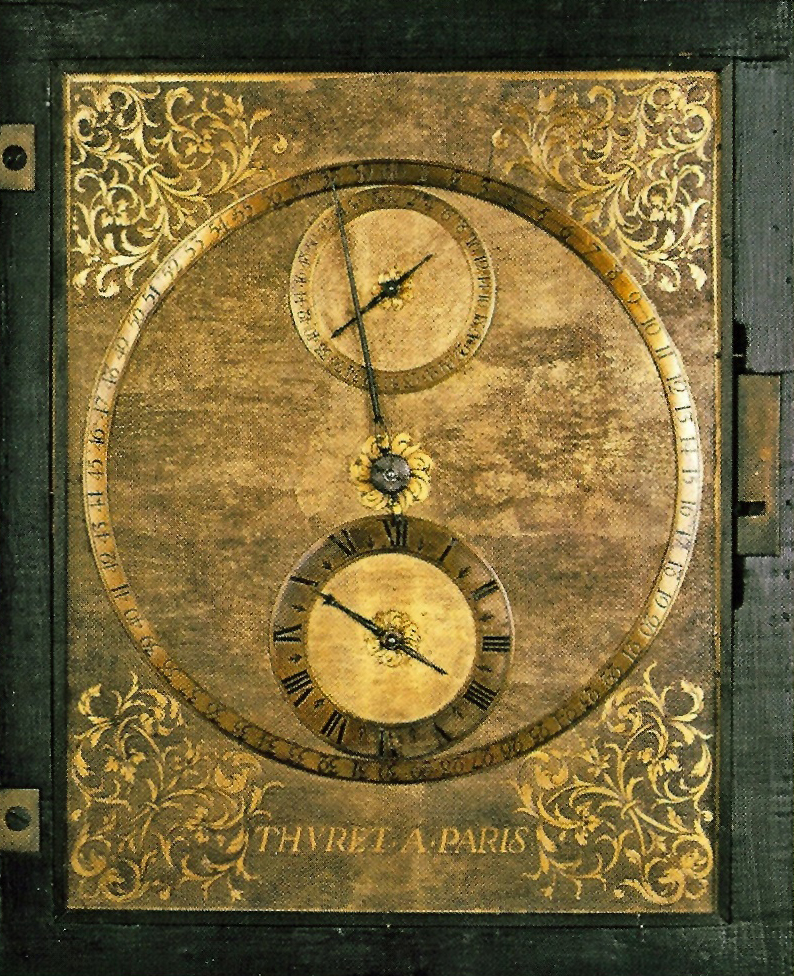
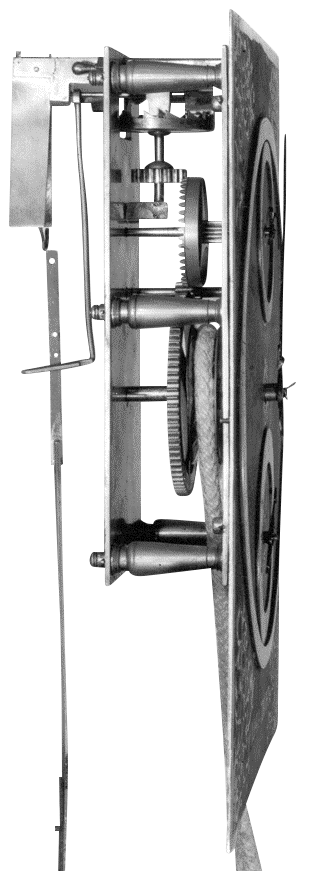


_full-bw.jpg)


